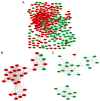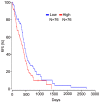Identification of key candidate genes and pathways in glioblastoma by integrated bioinformatical analysis
- PMID: 31602219
- PMCID: PMC6777220
- DOI: 10.3892/etm.2019.7975
Identification of key candidate genes and pathways in glioblastoma by integrated bioinformatical analysis
Abstract
Glioblastoma (GBM), characterized by high morbidity and mortality, is one of the most common lethal diseases worldwide. To identify the molecular mechanisms that contribute to the development of GBM, three cohort profile datasets (GSE50161, GSE90598 and GSE104291) were integrated and thoroughly analyzed; these datasets included 57 GBM cases and 22 cases of normal brain tissue. The current study identified differentially expressed genes (DEGs), and analyzed potential candidate genes and pathways. Additionally, a DEGs-associated protein-protein interaction (PPI) network was established for further investigation. Then, the hub genes associated with prognosis were identified using a Kaplan-Meier analysis based on The Cancer Genome Atlas database. Firstly, the current study identified 378 consistent DEGs (240 upregulated and 138 downregulated). Secondly, a cluster analysis of the DEGs was performed based on functions of the DEGs and signaling pathways were analyzed using the enrichment analysis tool on DAVID. Thirdly, 245 DEGs were identified using PPI network analysis. Among them, two co-expression modules comprising of 30 and 27 genes, respectively, and 35 hub genes were identified using Cytoscape MCODE. Finally, Kaplan-Meier analysis of the hub genes revealed that the increased expression of calcium-binding protein 1 (CABP1) was negatively associated with relapse-free survival. To summarize, all enriched Gene Ontology terms and Kyoto Encyclopedia of Genes and Genomes pathways may participate in mechanisms underlying GBM occurrence and progression, however further studies are required. CABP1 may be a key gene associated with the biological process of GBM development and may be involved in a crucial mechanism of GBM progression.
Keywords: bioinformatical analysis; calcium-binding protein 1; differentially expressed genes; glioblastoma.
Copyright: © Li et al.
Figures






References
-
- Yano S, Miwa S, Kishimoto H, Toneri M, Hiroshima Y, Yamamoto M, Bouvet M, Urata Y, Tazawa H, Kagawa S, et al. Experimental curative fluorescence-guided surgery of highly invasive glioblastoma multiforme selectively labeled with a killer-reporter adenovirus. Mol Ther. 2015;23:1182–1188. doi: 10.1038/mt.2015.63. - DOI - PMC - PubMed
-
- Stupp R, Taillibert S, Kanner A, Read W, Steinberg D, Lhermitte B, Toms S, Idbaih A, Ahluwalia MS, Fink K, et al. Effect of tumor-treating fields plus maintenance temozolomide vs maintenance temozolomide alone on survival in patients with glioblastoma: A randomized clinical trial. JAMA. 2017;318:2306–2316. doi: 10.1001/jama.2017.18718. - DOI - PMC - PubMed
LinkOut - more resources
Full Text Sources
Research Materials
